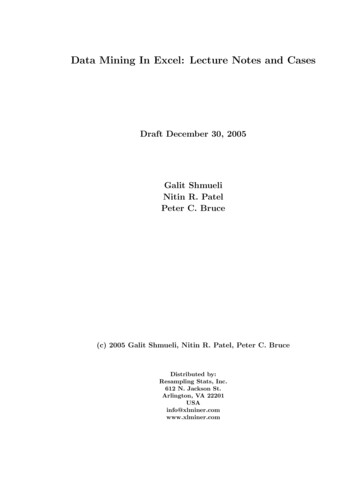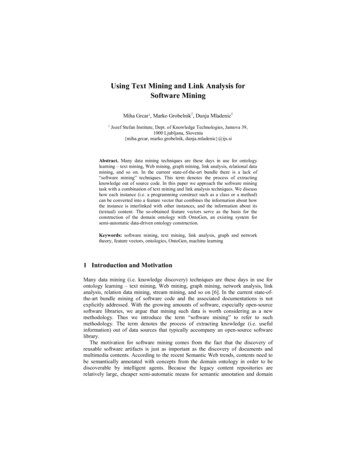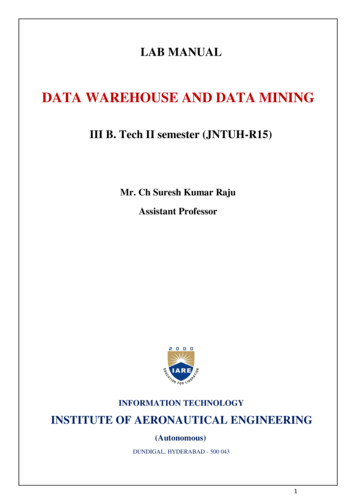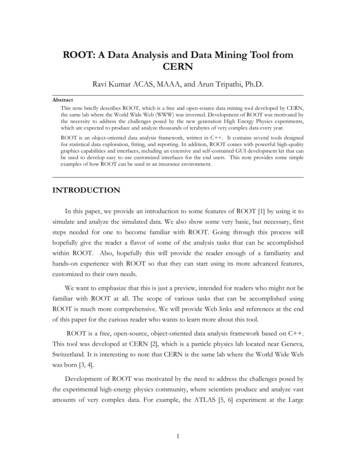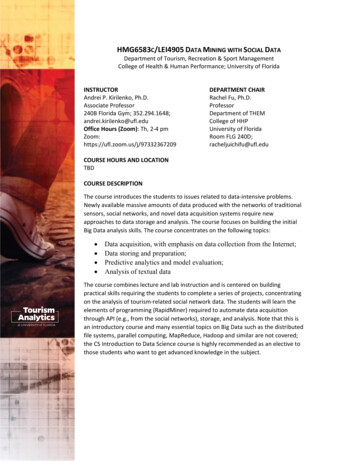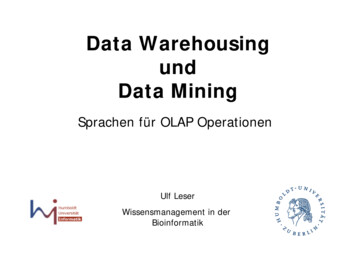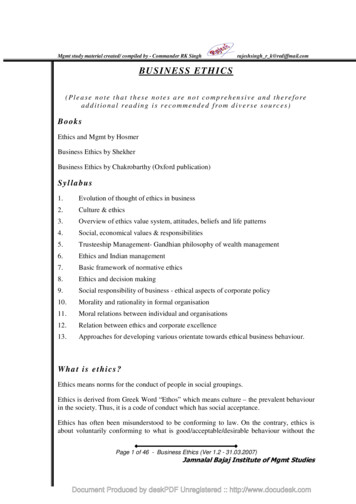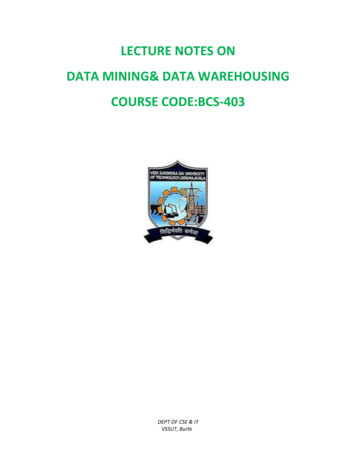
Transcription
LECTURE NOTES ONDATA MINING& DATA WAREHOUSINGCOURSE CODE:BCS-403DEPT OF CSE & ITVSSUT, Burla
SYLLABUS:Module – IData Mining overview, Data Warehouse and OLAP Technology,Data Warehouse Architecture,Stepsfor the Design and Construction of Data Warehouses, A Three-Tier DataWarehouseArchitecture,OLAP,OLAP queries, metadata repository,Data Preprocessing – DataIntegration and Transformation, Data Reduction,Data Mining Primitives:What Defines a DataMining Task? Task-Relevant Data, The Kind of Knowledge to be Mined,KDDModule – IIMining Association Rules in Large Databases, Association Rule Mining, MarketBasketAnalysis: Mining A Road Map, The Apriori Algorithm: Finding Frequent Itemsets UsingCandidate Generation,Generating Association Rules from Frequent Itemsets, Improving theEfficiently of Apriori,Mining Frequent Itemsets without Candidate Generation, MultilevelAssociation Rules, Approaches toMining Multilevel Association Rules, lDatabaseandDataWarehouses,Multidimensional Association Rules, Mining Quantitative Association Rules,MiningDistance-Based Association Rules, From Association Mining to Correlation AnalysisModule – IIIWhat is Classification? What Is Prediction? Issues RegardingClassification and Prediction,Classification by Decision Tree Induction, Bayesian Classification, Bayes Theorem, NaïveBayesian Classification, Classification by Backpropagation, A Multilayer Feed-Forward NeuralNetwork, Defining aNetwork Topology, Classification Based of Concepts from Association RuleMining, OtherClassification Methods, k-Nearest Neighbor Classifiers, GeneticAlgorithms,Rough Set Approach, Fuzzy Set Approachs, Prediction, Linear and MultipleRegression,Nonlinear Regression, Other Regression Models, Classifier AccuracyModule – IVWhat Is Cluster Analysis, Types of Data in Cluster Analysis,A Categorization of MajorClustering Methods, Classical Partitioning Methods: k-Meansand k-Medoids, PartitioningMethods in Large Databases: From k-Medoids to CLARANS, Hierarchical Methods,Agglomerative and Divisive Hierarchical Clustering,Density-BasedMethods, Wave Cluster:Clustering Using Wavelet Transformation, CLIQUE:Clustering High-Dimensional Space,Model-Based Clustering Methods, Statistical Approach,Neural Network Approach.DEPT OF CSE & ITVSSUT, Burla
Chapter-11.1 What Is Data Mining?Data mining refers to extracting or mining knowledge from large amountsof data. The term isactually a misnomer. Thus, data miningshould have been more appropriately named asknowledge mining which emphasis on mining from large amounts of data.It is the computational process of discovering patterns in large data sets involving methods at theintersection of artificial intelligence, machine learning, statistics, and database systems.The overall goal of the data mining process is to extract information from a data set andtransform it into an understandable structure for further use.The key properties of data mining areAutomatic discovery of patternsPrediction of likely outcomesCreation of actionable informationFocus on large datasets and databases1.2 The Scope of Data MiningData mining derives its name from the similarities between searching for valuable businessinformation in a large database — for example, finding linked products in gigabytes of storescanner data — and mining a mountain for a vein of valuable ore. Both processes require eithersifting through an immense amount of material, or intelligently probing it to find exactly wherethe value resides. Given databases of sufficient size and quality, data mining technology cangenerate new business opportunities by providing these capabilities:DEPT OF CSE & ITVSSUT, Burla
Automated prediction of trends and behaviors. Data mining automates the process of findingpredictive information in large databases. Questions that traditionally required extensive handson analysis can now be answered directly from the data — quickly. A typical example of apredictive problem is targeted marketing. Data mining uses data on past promotional mailings toidentify the targets most likely to maximize return on investment in future mailings. Otherpredictive problems include forecasting bankruptcy and other forms of default, and identifyingsegments of a population likely to respond similarly to given events.Automated discovery of previously unknown patterns. Data mining tools sweep throughdatabases and identify previously hidden patterns in one step. An example of pattern discovery isthe analysis of retail sales data to identify seemingly unrelated products that are often purchasedtogether. Other pattern discovery problems include detecting fraudulent credit card transactionsand identifying anomalous data that could represent data entry keying errors.1.3 Tasks of Data MiningData mining involves six common classes of tasks:Anomaly detection (Outlier/change/deviation detection) – The identification ofunusual data records, that might be interesting or data errors that require furtherinvestigation.Association rule learning (Dependency modelling) – Searches for relationshipsbetween variables. For example a supermarket might gather data on customer purchasinghabits. Using association rule learning, the supermarket can determine which products arefrequently bought together and use this information for marketing purposes. This issometimes referred to as market basket analysis.Clustering – is the task of discovering groups and structures in the data that are in someway or another "similar", without using known structures in the data.Classification – is the task of generalizing known structure to apply to new data. Forexample, an e-mail program might attempt to classify an e-mail as "legitimate" or as"spam".Regression – attempts to find a function which models the data with the least error.DEPT OF CSE & ITVSSUT, Burla
Summarization – providing a more compact representation of the data set, includingvisualization and report generation.1.4 Architecture of Data MiningA typical data mining system may have the following major components.1. Knowledge Base:This is the domain knowledge that is used to guide the search orevaluate theinterestingness of resulting patterns. Such knowledge can include concepthierarchies,DEPT OF CSE & ITVSSUT, Burla
used to organize attributes or attribute values into different levels of abstraction.Knowledge such as user beliefs, which can be used to assess a pattern’sinterestingness based on its unexpectedness, may also be included. Other examples ofdomain knowledge are additional interestingness constraints or thresholds, andmetadata (e.g., describing data from multiple heterogeneous sources).2. Data Mining Engine:This is essential to the data mining systemand ideally consists ofa set of functionalmodules for tasks such as characterization, association and correlationanalysis,classification, prediction, cluster analysis, outlier analysis, and evolutionanalysis.3. Pattern Evaluation Module:This component typically employs interestingness measures interacts with the datamining modules so as to focus thesearch toward interesting patterns. It may useinterestingness thresholds to filterout discovered patterns. Alternatively, the patternevaluation module may be integratedwith the mining module, depending on theimplementation of the datamining method used. For efficient data mining, it is highlyrecommended to pushthe evaluation of pattern interestingness as deep as possible intothe mining processso as to confine the search to only the interesting patterns.4. User interface:Thismodule communicates between users and the data mining system,allowing theuser to interact with the system by specifying a data mining query ortask, providinginformation to help focus the search, and performing exploratory datamining based onthe intermediate data mining results. In addition, this componentallows the user tobrowse database and data warehouse schemas or data structures,evaluate minedpatterns, and visualize the patterns in different forms.DEPT OF CSE & ITVSSUT, Burla
1.5 Data Mining Process:Data Mining is a process of discovering various models, summaries, and derived values from agiven collection of data.The general experimental procedure adapted to data-mining problems involves the followingsteps:1. State the problem and formulate the hypothesisMost data-based modeling studies are performed in a particular application domain.Hence, domain-specific knowledge and experience are usually necessary in order to comeup with a meaningful problem statement. Unfortunately, many application studies tend tofocus on the data-mining technique at the expense of a clear problem statement. In thisstep, a modeler usually specifies a set of variables for the unknown dependency and, ifpossible, a general form of this dependency as an initial hypothesis. There may be severalhypotheses formulated for a single problem at this stage. The first step requires thecombined expertise of an application domain and a data-mining model. In practice, itusually means a close interaction between the data-mining expert and the applicationexpert. In successful data-mining applications, this cooperation does not stop in the initialphase; it continues during the entire data-mining process.2. Collect the dataThis step is concerned with how the data are generated and collected. In general, there aretwo distinct possibilities. The first is when the data-generation process is under thecontrol of an expert (modeler): this approach is known as a designed experiment. Thesecond possibility is when the expert cannot influence the data- generation process: this isknown as the observational approach. An observational setting, namely, random datageneration, is assumed in most data-mining applications. Typically, the samplingDEPT OF CSE & ITVSSUT, Burla
distribution is completely unknown after data are collected, or it is partially and implicitlygiven in the data-collection procedure. It is very important, however, to understand howdata collection affects its theoretical distribution, since such a priori knowledge can bevery useful for modeling and, later, for the final interpretation of results. Also, it isimportant to make sure that the data used for estimating a model and the data used laterfor testing and applying a model come from the same, unknown, sampling distribution. Ifthis is not the case, the estimated model cannot be successfully used in a final applicationof the results.3. Preprocessing the dataIn the observational setting, data are usually "collected" from the existing databses, datawarehouses, and data marts. Data preprocessing usually includes at least two commontasks:1. Outlier detection (and removal) – Outliers are unusual data values that are notconsistent with most observations. Commonly, outliers result from measurementerrors, coding and recording errors, and, sometimes, are natural, abnormal values.Such nonrepresentative samples can seriously affect the model produced later. Thereare two strategies for dealing with outliers:a. Detect and eventually remove outliers as a part of the preprocessing phase, orb. Develop robust modeling methods that are insensitive to outliers.2. Scaling, encoding, and selecting features – Data preprocessing includes several stepssuch as variable scaling and different types of encoding. For example, one feature withthe range [0, 1] and the other with the range [ 100, 1000] will not have the same weightsin the applied technique; they will also influence the final data-mining results differently.Therefore, it is recommended to scale them and bring both features to the same weightfor further analysis. Also, application-specific encoding methods usually achieveDEPT OF CSE & ITVSSUT, Burla
dimensionality reduction by providing a smaller number of informative features forsubsequent data modeling.These two classes of preprocessing tasks are only illustrative examples of a largespectrum of preprocessing activities in a data-mining process.Data-preprocessing steps should not be considered completely independent from otherdata-mining phases. In every iteration of the data-mining process, all activities, together,could define new and improved data sets for subsequent iterations. Generally, a goodpreprocessing method provides an optimal representation for a data-mining technique byincorporating a priori knowledge in the form of application-specific scaling andencoding.4. Estimate the modelThe selection and implementation of the appropriate data-mining technique is the maintask in this phase. This process is not straightforward; usually, in practice, theimplementation is based on several models, and selecting the best one is an additionaltask. The basic principles of learning and discovery from data are given in Chapter 4 ofthis book. Later, Chapter 5 through 13 explain and analyze specific techniques that areapplied to perform a successful learning process from data and to develop an appropriatemodel.5. Interpret the model and draw conclusionsIn most cases, data-mining models should help in decision making. Hence, such modelsneed to be interpretable in order to be useful because humans are not likely to base theirdecisions on complex "black-box" models. Note that the goals of accuracy of the modeland accuracy of its interpretation are somewhat contradictory. Usually, simple models aremore interpretable, but they are also less accurate. Modern data-mining methods areexpected to yield highly accurate results using highdimensional models. The problem ofinterpreting these models, also very important, is considered a separate task, with specificDEPT OF CSE & ITVSSUT, Burla
techniques to validate the results. A user does not want hundreds of pages of numericresults. He does not understand them; he cannot summarize, interpret, and use them forsuccessful decision making.The Data mining Process1.6 Classification of Data mining Systems:The data mining system can be classified according to the
Data Mining overview, Data Warehouse and OLAP Technology,Data Warehouse Architecture, . Classification Based of Concepts from Association Rule Mining, OtherClassification Methods, k-Nearest Neighbor Classifiers, GeneticAlgorithms, Rough Set Approach, Fuzzy Set Approachs, Prediction, Linear and MultipleRegression, Nonlinear Regression, Other Regression Models, Classifier Accuracy Module .

